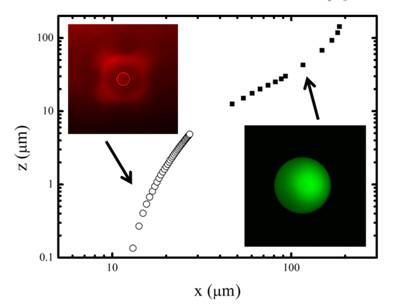58th Annual Report on Research 2013 Under Sponsorship of the ACS Petroleum Research Fund
Reports: DNI752062-DNI7: Biomimetic Soft Colloidal Materials
Andrew B. Croll, PhD, North Dakota State University
Damith Rozairo is a second year candidate for a Ph.D. in NDSU’s materials science and nanotechnology program, and is fully funded by this grant. He is primarily focused on the mechanics of emulsion droplets protected by an amphiphilic diblock copolymer. Damith has made significant progress to these ends, he has conducted micromechanical measurements on block copolymer armoured emulsion drops and has developed a new mechanical measurement technique. The new technique was necessary because we found that the micropipette based method is unreliable, and wanted an independent mechanical test. More interestingly, our method is not only effective with the emulsion drops, but also is effective with any soft spherical object (which could have considerable impact, given the popularity of soft colloidal systems). Additionally, Damith is detailing the mechanics of the thin block copolymer interfaces protecting the emulsion drops, and is experimentally investigating a very interesting drainage instability that occurs when an emulsion drop approaches a flat plate.
The mechanical technique we have developed uses buoyancy to deform a sphere against a freshly cleaved mica sheet. The result is easiest to understand if one considers a fluid sphere in contact with the mica. If the drop is small, the droplet will take on a spherical cap shape with a contact angle determined by the Young construction and will take on a deformed spherical shape govern by the Bashforth-Adams equation if it is large. Fitting the drop shape yields information about the interfacial tension, however, the tension is only unambiguously measured with the larger droplets. The geometry of the Bashforth-Adams regime is not trivial; to generate droplet shapes we implemented a numerical solution to the governing equations in Matlab. Figure 1 shows a typical drop shape observed by confocal microscopy.
With large fluid drops the experiment is very similar to a pendent drop experiment; however, our method is not constrained to work in this regime. We prove this point by examining droplets coated with a thin elastic shell of triblock copolymer. In this case Water/THF mixtures at varying weight fraction were created and a polystyrene-poly(acrylic acid)-polystyrene (PS-PAA-PS triblock is dissolved in the solvent mixture. The mixture is emulsified in toluene, and then re-emulsified in a glycerine/water mixture. The ultimate result is toluene droplets coated with a thin layer of PS-PAA-PS. The shell is in a highly elastic state, which is easily demonstrated as the membrane persists after crushing the droplets. The structure is still buoyed up by the density difference between toluene and water and is therefore deformed by the mica plate in an identical manner as the fluid drop.
Bekele Gurmessa is a second Ph.D. student working part-time under this grant. Bekele has been exploring the mechanics of collections of spheres, and has made some remarkable progress. He has coauthored 1 reviewed conference paper, and a second paper that has just been accepted to Granular Materials. He has been using a ‘wrinkling’ instability as a method to measure the mechanical response of a layer of solid polystyrene (or silica) particles. He has shown significant deviation from the predictions of a continuum wrinkling theory, and we have a fruitful collaboration with researchers in the granular materials community. Their excitement in our work stems from an interest in the collapse of granular materials, a basic and unsolved problem in discrete mechanics. We are currently working towards an understanding of the details of heterogeneity in the buckling process that precedes such failure.
We would also like to highlight the work of the summer student that was funded by this grant. We were concerned with the stability of the block copolymer layer itself and took on a Sophmore student (Peggy Willenbring) to do some experiments over the summer. Her work, while still in progress, has identified an important lengthscale associated with a ‘depletion’ region with respect to hole nucleation in a block copolymer lamella. The effect has not been noted before, and could have interesting patterning applications.
In closing, this PRF Doctoral New Investigator grant has already contributed 3 publishable works, and will generate at least 4 more. It has allowed my research group to maintain its current size, and has demonstrated to administrators that I have the ability to raise significant research funding. The PRF grant has funded bedrock research, which has created several new opportunities for the research group and has created useful output for the broader material science community. Because of the impact of this grant, two students have been funded to pursue their higher education, and one undergraduate has been exposed to the exciting world of research. Undoubtedly, the PRF-DNI award’s longest reaching effect is the opportunity for higher learning granted to these students.
Figure 1. The shape of a PS-P2VP armoured emulsion drop pressed into a mica sheet by the buoyant force. Note the high resolution data at the contact line (from the interferogram shown as an inset). The large scale data is created through optical sectioning of the micron scale droplet.
Copyright © 2014 American Chemical Society












